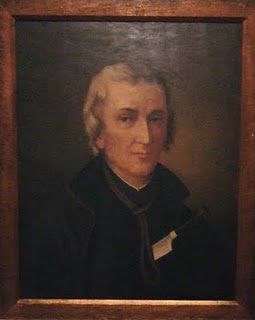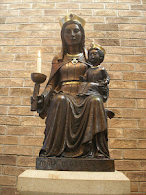In 1595 Fr Robert Jones arrived in England. The Jesuit General, Aquaviva, had sent him to assist Fr Robert Persons, Prefect of the English Jesuits. Fr Persons wished to provide for the needs of the many faithful Catholics in Wales. By 1605, Fr Jones had established a Jesuit mission closely involving the Welsh Jesuits, the Welsh Secular clergy and recusant gentry. This was largely financed by the Morgans of Llantarnam. Lady Frances (Somerset) Morgan was one of Fr Jones’s converts and Fr Jones sometimes lived at Llantarnam. This financial support made it possible to maintain two Jesuits in North Wales and two in South Wales. When Fr Jones died in 1615, Fr John Salisbury succeeded him as Superior of the North and South Wales Districts. Raglan Castle was a major Catholic centre and Fr Salisbury went to live there. The generous and continued support of the Morgans of Llantarnam and the Somersets of Raglan Castle enabled him to lease and eventually buy the farm known as the Cwm and to found there in 1622 the Jesuit College of St Francis Xavier. Over the years, the College of St Francis Xavier housed many priests, Seminary priests as well as Jesuits. It is interesting to note that, according to Br Henry Foley, Fr John Lloyd and Fr David Lewis were together at the Cwm in 1655. Fr John Lloyd was a secular or seminary priest who was martyred at Cardiff just days before Fr Lewis was martyred at Usk.
PHOTOS TO ENLARGE THEM)
Fr David Lewis served two terms as Rector of the Cwm, 1667 – 1672 and again from 1674 – 1678. As early as 1660 the Government authorities had know of the existence of the College of St Francis Xavier at the Cwm. The priests went about openly and unmolested until Titus Oates exploded upon the scene in 1678. Titus Oates was a detestable character who hated Catholics in general and Jesuits in particular. He claimed to have uncovered a plot to restore Catholicism to England by murdering the King, Charles II, and putting his Catholic brother James Duke of York on the throne. The King himself did not believe a word of the Plot but among a populace that believed Catholics responsible for the Great Fire of London as well as the Plague, it was easy for certain politicians to use the plot to serve their own purposes. The Oates Plot took wings and before it had ended, many innocent Catholics up and down the country had lost life and liberty.
Only two Jesuits at the Cwm were named in the spurious plot, Fr Charles Prichard and the Rector, Fr David Lewis. Fr Lewis was aware of the seriousness of the situation and decided to evacuate the Cwm and the priests dispersed. Some found shelter with Catholic families but most had to hide in woods, barns or caves. Through it all, those courageous and faithful priests, travelling by night and on foot, ministered to their scattered flocks. The Government ordered the Bishop of Hereford, Herbert Croft, to investigate the Cwm and in December 1678, Croft, with the exuberant assistance of John Arnold, John Scudamore and Charles Price, raided the College. The buildings were ransacked and among items taken away were the books from the Cwm’s extensive library. Many of the books were stolen by Croft to restock the library of Hereford Cathedral, which had been rifled by Cromwell’s Roundheads. About 100 volumes can still be seen in Hereford Cathedral Library.
Only two Jesuits at the Cwm were named in the spurious plot, Fr Charles Prichard and the Rector, Fr David Lewis. Fr Lewis was aware of the seriousness of the situation and decided to evacuate the Cwm and the priests dispersed. Some found shelter with Catholic families but most had to hide in woods, barns or caves. Through it all, those courageous and faithful priests, travelling by night and on foot, ministered to their scattered flocks. The Government ordered the Bishop of Hereford, Herbert Croft, to investigate the Cwm and in December 1678, Croft, with the exuberant assistance of John Arnold, John Scudamore and Charles Price, raided the College. The buildings were ransacked and among items taken away were the books from the Cwm’s extensive library. Many of the books were stolen by Croft to restock the library of Hereford Cathedral, which had been rifled by Cromwell’s Roundheads. About 100 volumes can still be seen in Hereford Cathedral Library.
 The lease on the Cwm did not expire until 1737 but after 1678, it was never again occupied by Jesuits. Eventually, the old house, which was said to have at least two priest holes, was demolished. In 1830 the present house was built. Today, the Cwm, nestled in gentle countryside, is a beautiful Bed and Breakfast Hotel. Catholicism in South Wales never fully recovered! Neither did it die out so the priests who tended the Catholics of Monmouth and the Welsh marches did not suffer or die in vain. The Faith lives on and their memory is revered.
The lease on the Cwm did not expire until 1737 but after 1678, it was never again occupied by Jesuits. Eventually, the old house, which was said to have at least two priest holes, was demolished. In 1830 the present house was built. Today, the Cwm, nestled in gentle countryside, is a beautiful Bed and Breakfast Hotel. Catholicism in South Wales never fully recovered! Neither did it die out so the priests who tended the Catholics of Monmouth and the Welsh marches did not suffer or die in vain. The Faith lives on and their memory is revered.









.JPG)

.JPG)






I always learn so much when visiting your blog! Thank you! Cathy
ReplyDeleteThanx for your brilliant idea on my Blog. I have responded there agreeing with you.
ReplyDeleteGod bless.
This is so interesting, Cathy! What great history and neat blog. Thanks for stopping by my place and I hope to be popping over here more often. God's abundant blessings to you:-)
ReplyDeleteHello GrandmaK
ReplyDeleteThank you for visiting and for commenting. Comments are always a useful way to gage a post, sort of indicating if some feature should be added or taken away. Anyway, I always appreciate your visits and your comments and suggestions. Thanks and God bless you, Cathy. By the way, your blog ALWAYS GIVES ME A LIFT! Thanks for that too.
Hello Victor
ReplyDeleteThanks for stopping by. I am well pleased that I am not alone in my thinking on suitable attire for church. I enjoy Fr Ignatius very, very much. God bless you, Victor.
Hi Tiffany
ReplyDeleteLovely to hear from you! Thanks for your kind words. I look forward to many more visits from you. God bless you.
I left a comment yesterday but it must have ended up in cyberspace :)
ReplyDeleteWonderful post, thank you.
Hi Daily Grace
ReplyDeleteFunny things happen sometimes with computers, don't they? Last night mine wouldn't allow me to sign out! It can be pretty annoying but we would be lost without them now. Anyway, it is good to hear from you and I thank you for your kind comment. God bless you.
Thank you for this very informative post. You will be interested to hear that the online Catholic TV station, Shalom World, is broadcasting a series of documentaries on all the Forty English and Welsh Martyrs. You can see the ones already shown at https://www.shalomworld.org/show/40-martyrs-of-england-&-wales. A new series, including an episode on St David Lewis, is just starting, and these will be added to the others as each is shown.
ReplyDelete